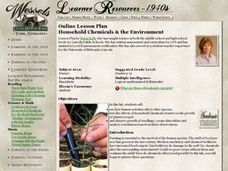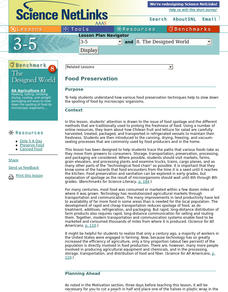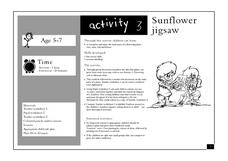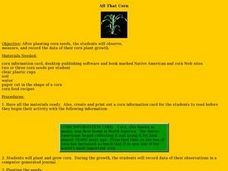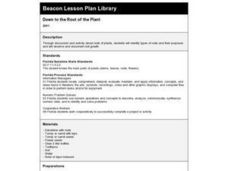Curated OER
The Ice Age
Students study the differences in the Ice Age terminology and what causes them. In this Ice Age lesson students examine what plants and animals lived during the Ice Age.
Curated OER
Dirt Babies
What exactly is a dirt baby, you might ask. Look over the plan to find out! All of the materials and procedures necessary for creating a dirt baby, such as grass seeds, dirt, and nylon stockings, are listed, along with ideas for...
Curated OER
Household Chemicals & the Environment
High schoolers conduct a laboratory experiment designed to investigate the effects of chemicals, soil quality and pollution on seed growth and plant yield. They consider how best to maximize agriculture in the long term.
Curated OER
Cloze Activity: Rainforests
In this rainforests cloze procedure worksheet, students review a brief selection that is missing 16 words and then attempt to fill in each blank with a word they think the author might have used. A word bank is provided.
Curated OER
Water, Water, Everywhere and Always on the Move
Pupils create their own water cycle in a terrarium. In this water cycle lesson, students research the water cycle and complete a worksheet using the Internet. They create a water cycle of their own in a jar with stones, sand, soil, and...
Curated OER
Coevolution: A Simulation
Students participate in a demonstration in which they must attempt to suck liquid from varying containers with straws of varying sizes. They discuss the concept of coevolution and see why this activity illustrate the coevolution of...
Curated OER
Flower Dissection
Students investigate th anatomy of a flower. They investigate the structures and processes by which flowering plants generate pollen, ovules, seeds, and fruit through dissection,
Curated OER
How is Rice Harvested?
Second graders look at how rice is harvested. For this rice harvesting lesson, 2nd graders learn vocabulary associated with rice harvesting. They read or listen to a study guide before making Squishy Rice Balls from balloons and rice.
Curated OER
Sense-sational
Learners investigate the five senses. They participate in the lesson for one week with each day devoted to one sense being sight, taste, sound, smell, and touch. They also cover the concept of being part of a global community where one...
Curated OER
BREAD IN A BAG
If possible, acquire a handful of wheat kernels from a local farmer or seed dealer. Hand them out so students can feel them and see what they look like. Share background information. 2. Draw a wheat kernel on the chalkboard, or use the...
Curated OER
Sorting
Students explore how books are sorted in a library. In this sorting lesson, students play a game where they have to fill the shelves with books that share a common theme. Students compare this game to a real library. Students discuss how...
Curated OER
Patterns in Nature
In this patterns in nature activity, students read about the Fibonacci Spiral, then follow the directions to plot one on the graph paper and draw the spiral, with links to more information.
Curated OER
Tree Identification/Tree Art
Seventh graders identify and examine a deciduous and coniferous tree. Using the descriptions, they discover the types of tress in their local area. As a class, they practice identifying trees on a walk in a park collecting leaves. They...
Curated OER
Ho'opiha - Growing in Knowledge: Terrarium Project
Learners explore environmental protection by conducting a research experiment in class. In this botany lesson plan, students identify the necessities for growing a plant indoors and create a small terrarium for their plant. Learners...
Curated OER
Sunflower Jigsaw
Students recognize and name the main parts of a flower. In this life science lesson, the teacher leads a discussion about the parts of a plant, then students color and cut out the parts of a planet, then glue the parts together...
Curated OER
All That Corn
Young scholars observe and record data. In this plant growth instructional activity, students plant and grow corn. Young scholars observe the growth of their corn and record their data. Students read corn recipes and...
Curated OER
The Best Gift, for Shoe-er!
Students turn an old shoe into a memorable planter that's a terrific gift for Mother's Day or any other occasion.
Curated OER
Cells, Cells, Cells
Young scholars explore plant and animal cells. Using household items, students create a three-dimensional model of a plant or animal cell. Young scholars identify and label each cell part.
Curated OER
Pollen & Pollination
Young scholars identify the different ways things are pollinated and how to manage pollen. In this pollination lesson students complete an experiment on how moths pollinate flowers.
Curated OER
Down to the Root of the Plant
Second graders identify types of roots and their purposes and observe and document root growth. students observe their roots once a week and measure them to see if there has been any change. Each student keeps a written log of the...
Curated OER
Introduction to Nutrition and Gardening
Learners examine the different parts of a plant and each ones role. In this exploratory lesson students complete several activities including a game of charades.
Curated OER
The Ancient Cycads
In this cycads instructional activity, learners will read a short essay on the cycad tree, including it's reproductive strategies and it's general characteristics. Then students will complete 2 short answer questions based on what they...
Curated OER
Arizona Grown Specialty Crop Lesson Plan: Where Do They Go?
Students explore biotic and abiotic factors in landscape design. In this landscaping lesson, students create 3-dimensional models that represent landscape designs taking into consideration climate and planting requirements.
Curated OER
Dichotomous Key for Identifying Pine Trees
Students identify the species of pine trees that are found in their area. They use unlabeled "mystery" samples and a dichotomous key to identify the pine trees to species. After identification, they use a field guide to answer worksheet...


